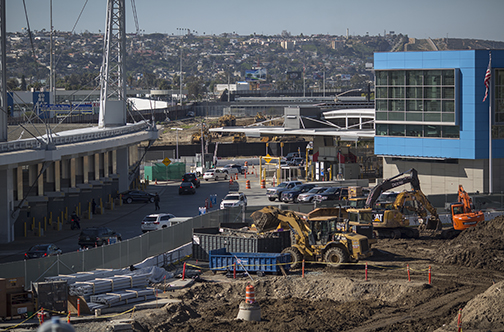
President Donald Trump has ordered work to begin on building a wall along the Mexican border, angering his southern neighbor with his hardline stance on immigration. / AFP PHOTO / DAVID MCNEW
President Trump stands behind his campaign promise to build a wall along the entire U.S.-Mexican border. On the campaign trail, he insisted he could get the job done for no more than $10 billion because he is the master of completing construction projects quickly and under budget. This past weekend the president took to Twitter to lash out at reports that the true cost of the border wall would be well north of $10 billion.
The critics are almost certainly correct. Mr. Trump fails to take into account the major hurdle the wall faces: eminent domain.
To build the wall, the U.S. would need to own all 1,954 miles of the border. Most of this land is now private property—especially in Texas, where the U.S. government owns only 100 miles of the 1,254-mile border. To acquire the rest of the land it would need, Washington would need to employ eminent domain, the authority under the Fifth Amendment to seize private property for public use upon payment of “just compensation.”
Recent history shows that’s easier said than done. In 2006 Congress passed the Secure Fence Act with strong bipartisan backing, including the support of New York Democrat Chuck Schumer, now Senate minority leader. The law authorized construction of a border fence along 700 miles of the U.S.-Mexico border, including 100 miles in Texas. Lawmakers expected swift completion of the project.
Instead, a decade later, there are unfenced gaps—because the fence had to have holes to accommodate local ranchers whose cattle graze on the southern side, but also due to property owners’ fighting land seizures in federal court.
At the end of 2016, more than 120 separate cases pertaining to eminent-domain seizures for the fence were still active in the U.S. court system. In 2009 the Department of Homeland Security inspector general issued a report that noted, “Acquiring real property from non-federal owners is a costly, time-consuming process requiring negotiations and sometimes condemnation.”
The cost of paying landowners “fair market value” is often higher than estimated. In building the border fence, Reuters reported, the U.S. government ended up paying $4.7 million for one developer’s land when the initial offer was $233,000. It shelled out $1 million to the Sierra Club after originally proposing $114,000 for another parcel.
The high cost is a feature, not a bug. The Fifth Amendment is part of the Bill of Rights, and while it recognizes the government’s authority to condemn land, its purpose is to protect property owners from confiscation.
How could Mr. Trump overcome this obstacle? He may be a great negotiator, but for logistical reasons alone it’s unlikely he can personally make a deal with each of the hundreds, if not thousands, of landowners who’d turn to the courts to resist the seizure. And his own record in this regard isn’t promising. In the 1990s he failed to persuade Vera Coking, an Atlantic City, N.J., widow, to sell her house on the site of a proposed Trump Plaza parking lot. The city’s Casino Reinvestment Development Authority attempted to force her out using eminent domain, but Mrs. Coking prevailed in court.
The president is right to focus on border security. At present, it is quite easy to enter the U.S. illegally. But an estimated 40% of illegal aliens entered the U.S. legally and overstayed their visas. A wall would do nothing about those overstays. Thus Mr. Trump would be prudent to move away from a physical wall to one that is “virtual” or “electronic.” That would entail investing in electronic surveillance equipment such as drones and motion sensors that the Border Patrol could use to enhance its operations. Immigration and Customs Enforcement could also expand the E-Verify system, which checks aliens’ employment eligibility, to track the location of foreign visitors and reduce visa overstays.
Surely Mr. Trump has the persuasion skills to sell his supporters on this tough but practical approach. It would also earn him the backing of Democrats from border areas and even some of the Democratic base. More important, the president would avoid seizing Americans’ private land—a policy that is anathema to the conservatives who overcame their doubts to vote for him.

DONALD TRUMP IS ONE DUMB FU@K! THIS FOOL IS HELL BENT ON BUILDING A FRICKING WALL!!! CELEBINCHIEF, YOU ARE ONE WITLESS, LAUGHING STOCK! IN THE WORLD WE OCCUPY TODAY, THIS IS TRULY YOUR FIRST ORDER OF BUSINESS????? WOWZER! :bingung
Try kno seh him will empty America piggy bank some way some how just fi prove a point and build di damn wall. Everybody a talk bout nuff a wah him a call illegal. But guess wah him still a do it, and him could care less bout the outcome! Trump will continue to be wah him a do because him hav ppl weh a be him and willing to fight for him!
Trump not buying squat. He’s going to shout Eminent domain and tek di people dem land..
All I know by the end of this year America will have a huge number of broken families and less money in the current account at the central bank cuz this fool insist oj proving him self.